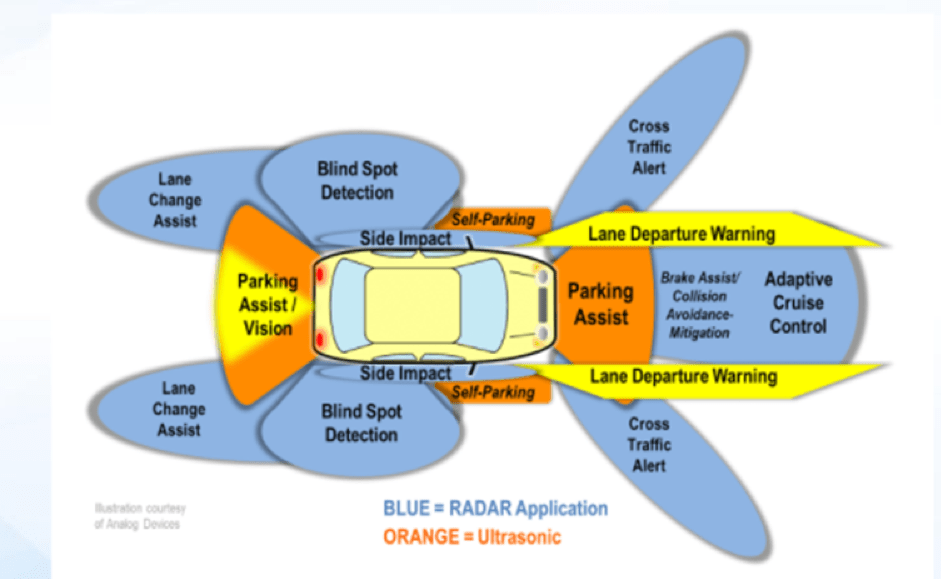Today's auto mechanics who undergo automotive radar training are called "autotronics technicians." They must be knowledgeable about the part of the electromagnetic spectrum called millimeter waves, located between microwave and infrared waves. This frequency range covers 30 gigahertz (GHz) to 300 GHz. It allows for faster digital communications using radar and 5G. Here's a look at how millimeter waves facilitate automotive radar training and testing.
Evolution of Automotive Radar
Radar technology was developed from radio technology prior to WWII and was crucial for the Allied forces to prevail. This century several industries such as automotive and healthcare are gearing up for 5G as they go through digital transformation to exchange data through faster wireless connections. Automotive radar now delivers valuable insights that particularly help transportation companies monitor each vehicle of their fleets in real time at any time.
Automotive Radar Challenges
Just like with 5G, automotive radar faces critical challenges that relate to equipment calibration and testing. No one doubts the greatly enhanced robust nature of automotive radar, as it provides faster data transmission over wider bandwidth than what the professional world has experienced the first two decades of this century. While automotive radar has primarily been installed in premium models, development needs greater efficiency in order to expand into the mainstream automotive market.
Some of the most important challenges for millimeter wave applications include how much coverage a transmitting antenna provides and how port devices are managed. Packages of integrated antennas must be calibrated for suitable wireless coverage concentrated in a certain area. The more antennas used in a wireless application, the better power efficiency, as antennas must be pointed in a direction of concentrated power to get clean coverage without interference.
Multiple coverage area targets can be tracked and tested with the help of radar steering controls. Automotive radar enhances this capability to allow communication from one moving vehicle to another. As automotive radar devices become more complex, multiple combinations of transmitting and receiving antennas are increasingly necessary to provide desired coverage. This concept is part of the force behind remotely-controlled autonomous vehicles.

Devices used in these applications include advanced features such as high-port-count switching/multiplexing. Another challenge is the use of multiple sophisticated features on a device, such as the combination of a die-MCU, memory, radio and ultimately high-speed digital transmission. Meanwhile, transceiver design can be optimized with zero-intermediate frequency (IF) design.
Automotive vs 5G Radios
Automotive radios look similar to 5G radios in terms of components such as IP blocks, phase shifters, oscillators, RF amplifiers and mixers. The main difference is that automotive radios have up and down modulation capabilities, whereas the focus of 5G consumer applications has centered on broadband expansion.
Both auto radar and 5G have four main hurdles to overcome: rain attenuation, Fresnel zone, path loss and ground reflection. These issues affect both stationary towers and moving vehicles. Autotronics technicians must approach these issues with a system level perspective for testing. With 5G, beams are pointed at towers and mobile handsets for tracking and testing, while automotive radar is more complex and requires higher-level end-to-end testing rather than just component-level testing.
Where Automotive Radar is Moving
Despite tough challenges ahead, it's clear that automotive radar is here to stay. The technique of RF beamforming involves positioning transmitters and receivers to concentrate effectively in a certain direction. Active RF beamforming has been eclipsing the more limited passive approach due its capability of tracking multiple objects whether static or in motion at various speeds.
In order to improve auto radar, precision power output measurement will be essential, as technology moves toward built-in self test (BIST) solutions. Accurate measurements will also be crucial for the metrology of various components to detect wear and tear so that parts can be replaced when needed.
As auto radar equipment becomes more advanced to increase coverage range, it will be essential to measure system noise in RF signals. Reducing the signal-to-noise ratio will be crucial to limit its degrading impact on signal transmission performance. In order to reach this goal of more effective radar coverage, the cost of millimeter-wave technology will need to decrease.
Another challenge for auto radar developers will be compensating for the current shortage of engineers working on millimeter technology. The engineering world has focused on digital transformation instead of analog/RF, which accounts for the scarcity of engineers who are knowledgeable of auto radar technology. Growth in this area will help lower engineering costs.
Conclusion
Development of enhanced automotive radar training for vocational users such as autotronics technicians is currently in a pioneering stage. In order for auto radar technology to improve and become more widespread, the cost of unit production must come down unless alternative solutions materialize through new technology. Once this goal is achieved, auto radar can become standard equipment in the automotive industry.
References & Further Reading
- Radar: the road to an autonomous vehicle (retrieved: 15.04.2021)
- 5G Lessons Learned From Automotive Radar Test (retrieved: 15.04.2021)




